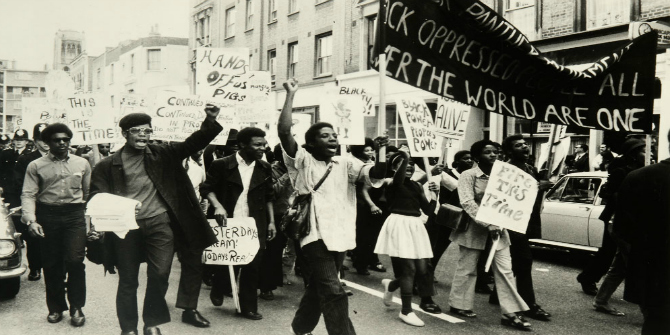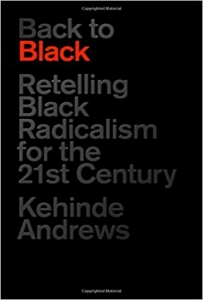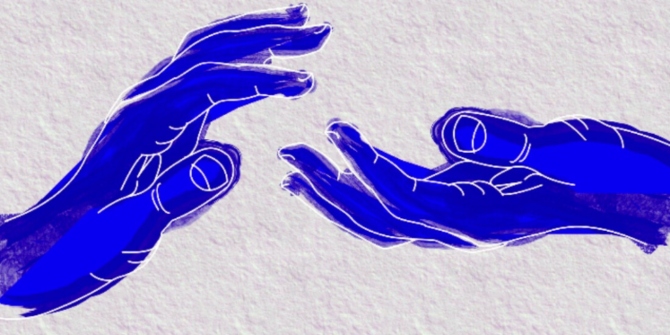In Back to Black: Retelling Black Radicalism for the 21st Century, Kehinde Andrews offers a new critical history of Black radical politics, exploring its foundations and key tenets and critiquing its applications in order to outline a vision of Black radicalism for the present. In this long read review, Amal Abu-Bakare examines the book’s contribution, reflecting particularly on the limitations of its understanding of political Blackness.
Back to Black: Retelling Black Radicalism for the 21st Century. Kehinde Andrews. Zed Books. 2018.
What kinds of Blackness do we include?
Amidst contemporary British politics – whether it be the current government’s endeavours to curtail ‘radicalisation’ in the context of ‘far right’ and Daesh-inspired violence or continued political contestation over the ways activists and academics condemn incidents of institutionalised racism, such as the ongoing deportation of British Commonwealth citizens of the Windrush generation – the mechanisms to productively engage in political resistance are of ever-increasing importance. Kehinde Andrews’s latest book, Back to Black: Retelling Black Radicalism for the 21st Century, offers a critical perspective.
Back to Black addresses these geopolitical issues head on, centring the condition of anti-Blackness in Western politics. Andrews’s overarching argument is that the answer to incidents of Black oppression is Black radicalism, a concept which, as a consequence of its association with numerous nationalisms and ‘Black’ political movements, has traditionally been misunderstood. For Andrews, the word ‘radical’ has a very specific meaning, inspired by Angela Davis, where radicalism means grasping an idea at ‘the root’ and ‘rejecting the fundamental principles that govern society’ (xviii). Similar to the theoretical stance of David Theo Goldberg (2002), Andrews argues that the Western nation-orientated state is essentially racist and anti-Black at its foundations. This necessitates true pro-Black advocacy to emanate from outside its boundaries by ‘creating a new paradigm’ (xxi). The aim of Back to Black is to lay this out, and properly present the foundation and tenets of the Black radical project to defend its application in the twenty-first century (xxiv).
The book is organised as a chapter-by-chapter structured critique of several traditions of Black politics. Andrews begins his argument for Black radicalism in the first chapter, examining Black Nationalism as a complex ‘system of meaning’ that juxtaposes integrationist philosophies, before assessing its capacity to challenge the global socioeconomic order (6). In this and his second chapter on the topic of pan-Africanism, Andrews undertakes an exhaustive critique of the political practices of Black empowerment that are dependent on or operate within the boundaries of the Western state apparatus. For Andrews, pan-Africanism, while hoping to overturn the systematic ramifications of the slave trade and colonialism (i.e. through reparations or political lobbying), does not challenge the imperial structures that ensure Black oppression (53). Andrews repeatedly argues that the nation state at its core is ‘a controlling idea, rather than a reality’, and that for Black radicalism to be possible, its dominance must be undone (71).
Back to Black’s third and fourth chapters assess the possibility of a non-territory-orientated global movement predicated on a unified historic connection to cultural genocide; a Black diaspora originating from Africa; or a belief in a shared ‘Black culture’. Here Andrews notes the often capitalist, androcentric and misogynistic tendencies of believers of what he describes as ‘cultural nationalism’, alongside the epistemic disadvantages that cultural nationalism presents as a mode of political resistance where reclaiming culture becomes the ‘end point to liberation itself’ (112).
 Image Credit: Protesters demonstrating against the trial of the Mangrove Nine, West London, 1970. Catalogue reference: MEPO31/21 (3) (The National Archives UK, No Known Copyright Restrictions)
Image Credit: Protesters demonstrating against the trial of the Mangrove Nine, West London, 1970. Catalogue reference: MEPO31/21 (3) (The National Archives UK, No Known Copyright Restrictions)
Andrews dedicates the remaining chapters to clarifying other topical misunderstandings of Blackness, such as the association of Blackness with the support of violence; the potential for activities centred around Blackness to gravitate towards essentialism and misogynoir; and the limitations of Blackness when viewed solely as racial affairs disconnected from political economy. Here, Andrews examines the political ramifications of Black radicalism itself, presenting an in-depth analysis of Black empowerment in relation to what he regards as foundationally white-centric movements of political liberation such as Marxism and Liberalism (or Liberal radicalism, using Andrews’s terminology).
Andrews concludes with a chapter that considers the importance of ‘Black survival’, making readers aware of the negative implications of blindingly following integrationist agendas and of existing in universities: institutions that have historically upheld the oppressive status quo intrinsic to neo-colonial administration and racial oppression. Andrews also maintains the importance of upkeeping community-orientated and community-funded efforts towards Black unity and consciousness.
A major part of Back to Black is dedicated to understanding the critical role of legacy in the politics of pedagogy, and how certain ideas, disciplines and institutions uphold legacies of anti-Blackness in supporting Western governments and colonial enterprises. For example, an important entity that Andrews confronts is the institution of post-secondary education, arguing that: ‘it is an on-going crisis of the Negro intellectual to be unable to articulate the radical nature of Blackness because of the limits of the White academic framework’ (176).
As a self-identifying Black intellectual and Professor of Birmingham City University, Andrews acknowledges his own contradictory position, yet insists that despite this, it is outside the university that the potential for authentic Black radicalism lies. According to Andrews: ‘The role of the academic is not to bring about social change but to reproduce the status quo, ‘‘the social relations of oppression and exploitation’’’ (243). Such conversations crucially encourage other Black intellectuals engaged in processes of academia, like myself, to consider what their political aims are as educators, and what power structures they are facilitating through their work. Are we as Black educators intending to change the racist nature of higher education and the public system, or are we further facilitating its production? These questions will provoke self-reflection amongst Back to Black’s readers who wish to promote political change in sectors of knowledge production.
It is important to emphasise that the discussion of Blackness spread throughout Back to Black is not in the conventional political (Blackness) sense known to Britain since Enoch Powell, of which British people of South Asian decent have historically claimed to be part. Instead, the book is an extensive study of Afro-Caribbean Black liberation, focused on a Blackness that is not ‘theoretical, literary or abstract’, but instead ‘a concept produced in struggle by those facing the brutal realities of racial oppression’ (176). The Blackness of Back to Black is attributed to the historic yet still relevant legacies of key figures of pro-Blackness, pan-Africanism and Black Marxism, including W.E.B. Du Bois, Marcus Garvey, Martin Luther King, Davis and Malcolm X. Andrews takes apart a number of movements associated with these icons, critiquing the validity of their aims to liberate Black people analytically, whilst upholding an argument that to truly engage in Black liberation, one must ultimately endeavour to overturn the system that upholds Black dehumanisation. To be clear, Back to Black does not completely disregard the efforts and motives of these scholars and activists: rather, Andrews is specifically contesting whether organisations like the Black Panther Party or the Nation of Islam (NOI) were ever truly close to their goal of Black liberation and, consequently, whether they truly engaged in what Andrews describes as Black radicalism.
It is here that an important lacuna within Back to Black’s conceptual framework becomes visible, particularly regarding Andrews’s lack of explanation of what constitutes ‘Black’. Likely due to his own scepticism of theories of racialisation, Andrews does not critique or acknowledge contestation around this term. Though debates over who has access to Blackness may be unnecessarily complicated in his eyes, arguably contestation around who has the right to claim Blackness does serve as a major barrier for ‘Black’ people whose experiences of racial struggle encompass worlds outside of British and North American milieus, yet who may still be able to contribute unique realisations in support of the Black radicalism project. Back to Black fails to account for the fact that within the West, various groups outside of the Afro-Caribbean community have also historically been blackened in a number of geopolitical contexts.
Any discussion of Blackness requires a political grounding: a grounding with clear delineations and engagement with a wider community, consisting of all those who have been blackened who need to know whether Andrews’s understanding of Blackness includes their Blackness too. There is a lack of adequate engagement within Back to Black with the dimensions of power that accompany subscribing to a Black political identity. Andrews hints at such issues in his chapter on ‘Black is a Country’, when he acknowledges the situation of political Blackness in Britain that is encompassing of Asian and other minority ethnic groups, yet he infers that these groups are not equally tied together by their experiences of racism in a manner that affords Asian and Black British people equal access to the Black radicalist project (79–80). If Andrews does not feel that all blackened communities – communities that faced anti-black racism due to perceptions rather than a subscription to the African Diaspora – are target audiences of his writings in Back to Black, then some validation should at least be presented as to why the ever-unresolved tensions that circulate between and within peoples who have been historically racialised as Black are disconnected from his notion of Black radicalism. There needs to be some acknowledgement of the structural ‘overdeterminations of unequal social relations’ that impact people’s relationship with the Black liberation struggle, otherwise whole categories of Blackness that preside within the international community remain untouched (Sayyid and Vakil 2017).
 Image Credit: (Modified image of Malcolm X taken from Daniel X. O’Neill CC BY 2.0)
Image Credit: (Modified image of Malcolm X taken from Daniel X. O’Neill CC BY 2.0)
A major point of critique of Back to Black is that despite having what can be described as an anti-racist agenda, Andrews chooses to leave the racialised connotations of what he denotes as ‘Islamic extremism’ intact, not contesting the racist term in his endeavour to distinguish Black radicalism from ideologies that can be seen as ‘bloodthirsty and seeking violent confrontation’ (xxi). This critique is not tangential to the book’s argument but directly implicates a key figure that Andrews upholds, Malcolm X, whose relationship with Sunni Islam in his final years served as an avenue for Malcolm to express his political aims of Black liberation. This is a point Andrews repeatedly overlooks when discussing Malcolm X’s legacy in Back to Black. In his final days, after his conversion to Sunni Islam, Malcolm still envisioned ‘a broad-based ‘‘pluralistic united front’’ that would unite integrationists and civic organizations with Black separatists, under the leadership of the Black [Sunni and Nation of Islam] Muslims’ (Aidi 2018, 413).
Per the arguments of Hisham Aidi (2018), Malcolm X’s embrace of Sunni Islam was not a separate matter from Malcolm’s Black politics, but integral to a greater Black liberation project unable to be completed as a result of his death. Malcolm X’s unpublished works demonstrate that as a result of political (and religious) alliances established in the Middle East and North Africa Region, Malcolm endeavoured to connect American Black integrationists and Black nationalists, with a broader political support base emanating from a range of postcolonial states. By situating himself in the middle of the Arab Cold War, being politically engaged in Nasser’s 1960s Egypt, Malcolm X had ‘the potential to become much more dangerous to white America’ in his attempts to bridge Black liberation and political but still Muslim social movements (Aidi, 413).
Since Andrews makes reference to ‘the Arab Invaders into North Africa’ in his epilogue (288), he is clearly aware of the controversies surrounding anti-Blackness in relation to Islam or political institutions, such as that of the Indian Ocean Slave Trade, that have historically supported Muslim-identifying populations. As a result of Muslim empires participating for centuries in the international slave industry, trafficking Black non-Muslims of the African continent, it is important that one does not immediately apply Blackness to Islam, or to any Abrahamic religion uncritically. Yet, it is also important that we do not ignore that the imagined Muslim world has often been host to a ‘Black’ community, where numerous Black liberation figures such as Edward Wilmot Blyden (1875), Du Bois (2004) and Malcolm X found, or noted why others found, solace, observing how Muslim social movements tended to embrace Black liberation (although usually in the aftermath of religious conversion). Such observations are not without complications. While Muslim polities have historically been cast as Black solely in juxtaposition to a perceived white Christian civilisation, historically Muslim polities have also upheld anti-Blackness, particularly in their efforts to contest their own racialisation and subsequent dehumanisation amidst Muslim enlightenment thinking (Aydin 2017).
This may, per Andrews’s arguments, make these Black icons identifying with (Sunni) Islam less ‘radical’, but it does not make their histories with Blackness or the very existence of such avenues of Black liberation thought any less ‘Black’. In his choice to leave such stones unturned, Andrews presents a secular and Western-centric vision of what Blackness entails and, arguably, a too simplistic view of what truly engaging in Black radicalism means. This is highly significant, as at present on both the counterterrorism policy and Black Lives Matter-orientated fronts that Andrews alludes to in the preface of Back to Black, the existence of Black Muslims, as migrants to and citizens of the West, is repeatedly erased; and their realities of political struggle repeatedly marginalised in anti-racist discourses. Black Muslims’ Black and religious identities are continuously imagined to be separate or hierarchal, at a time in geopolitics when racial and religious politics are very much ‘conjoined twins’ (Vial 2016,1).
So as to not end this review on a point of critique, I would like to emphasise a promising and hopeful avenue that Andrews does pursue: his discussion of Black survival near the conclusion. Andrews shows humility in understanding that many academics engaged in anti-racist and pro-Blackness movements, while not being radical or liberation-orientated affairs, are still fulfilling an important function of ‘creating structures in the West to help’ activists, academics and students survive the system, facilitating the ability and endeavours of those who can afford or are able to play their part in what Andrews describes as ‘a global revolutionary struggle’ (273).
At this point in global affairs, many academics of colour existing across multiple worlds feel that they are at an impasse: uncertain as to whether it is our responsibility to engage in anti-racist education to survive or to allow our students to achieve more than our generation has achieved, inspiring them to foresee a political life that is truly liberated from oppression. This is a dilemma that will resonate with feminists, decolonisers and activists from a wide range of backgrounds as the question of what is deserved: survival or liberation? And of what is attainable: survival or liberation? Andrews’s book inspires such reflection, and what is to be gained from Back to Black is the inferred possibility and perceived hopefulness of the existence of an anti-oppressive society. Nonetheless, if it is those who are ‘Black’ who are to lead us to this, then it is all those who are ‘Black’ that must eventually be properly identified by Andrews and accordingly embraced, along with all of their complexities.
- This review originally appeared at the LSE Review of Books.
Please read our comments policy before commenting.
Note: This article gives the views of the authors, and not the position of USAPP– American Politics and Policy, nor of the London School of Economics.
Shortened URL for this post: http://bit.ly/2DiVJma
About the reviewer
Amal Abu-Bakare – Aberystwyth University
Amal Abu-Bakare is a doctoral student at Aberystwyth University. Her current project is entitled The ‘Colour’ of Counterterrorism: A postcolonial analysis of racialisation in British and Canadian counterterror approaches. Using William Edward Burghardt Du Bois’s concept of the colour line in the context of International Relations Theory, Amal examines the politics of counterterrorism practices and the actions of ‘policymakers’, this label encompassing members of parliament, police, researchers and civil society actors who contribute to discourse on the products emanating from the British government’s Tackling Extremism in the UK policy and the Canadian Anti-Terrorism Act of 2015. Amal identifies as a Black Muslim Feminist, and is interested in social justice, art and media projects that address the intersections between race, gender and religion. Amal frequently writes and comments on Twitter @nawalabu_72 and her blog colouredacademia.


 Find this book:
Find this book: 



